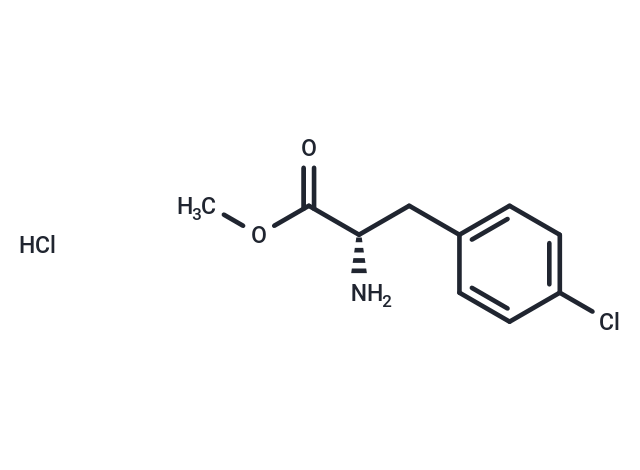Shopping Cart
- Remove All
 Your shopping cart is currently empty
Your shopping cart is currently empty

pCPA methyl ester hydrochloride (4-Chloro-DL-phenylalanine methyl ester hydrochloride) is an inhibitor of tryptophan hydroxylase inhibitor and 5-HT synthesis. pCPA methyl ester hydrochloride is permeable across the blood-brain barrier and reduces 5-HT central availability.

| Pack Size | Price | Availability | Quantity |
|---|---|---|---|
| 200 mg | $29 | In Stock |
| Description | pCPA methyl ester hydrochloride (4-Chloro-DL-phenylalanine methyl ester hydrochloride) is an inhibitor of tryptophan hydroxylase inhibitor and 5-HT synthesis. pCPA methyl ester hydrochloride is permeable across the blood-brain barrier and reduces 5-HT central availability. |
| In vivo | In C57BL/6 elite male mice, 5-HT levels decreased by 85% and 55% in the hippocampus of mice treated with oral or i.p. PCPA methyl ester hydrochloride(250, 500 mg/kg), respectively, whereas in the prefrontal cortex, 5-HT levels decreased by 65% and 50%[4]. |
| Alias | 4-Chloro-DL-phenylalanine methyl ester hydrochloride |
| Molecular Weight | 250.12 |
| Formula | C10H13Cl2NO2 |
| Cas No. | 14173-40-1 |
| Smiles | Cl.COC(=O)[C@@H](N)Cc1ccc(Cl)cc1 |
| Storage | store at low temperature | Powder: -20°C for 3 years | In solvent: -80°C for 1 year | Shipping with blue ice. | |||||||||||||||||||||||||||||||||||
| Solubility Information | H2O: 45 mg/mL (179.91 mM), Sonication and heating to 60℃ are recommended. DMSO: 245 mg/mL (979.53 mM), Sonication is recommended. | |||||||||||||||||||||||||||||||||||
Solution Preparation Table | ||||||||||||||||||||||||||||||||||||
H2O/DMSO
| ||||||||||||||||||||||||||||||||||||

Copyright © 2015-2025 TargetMol Chemicals Inc. All Rights Reserved.